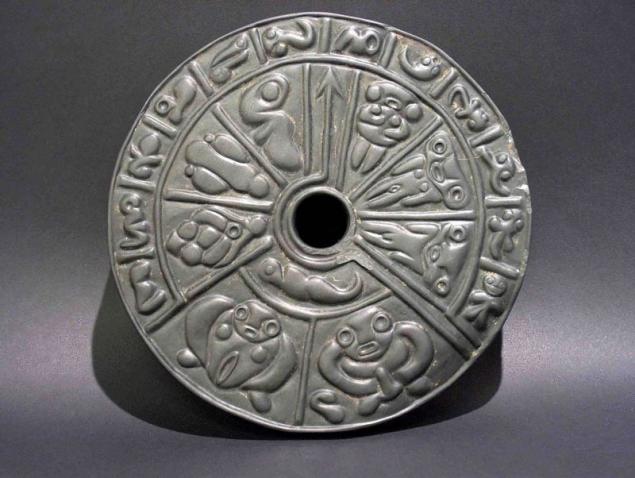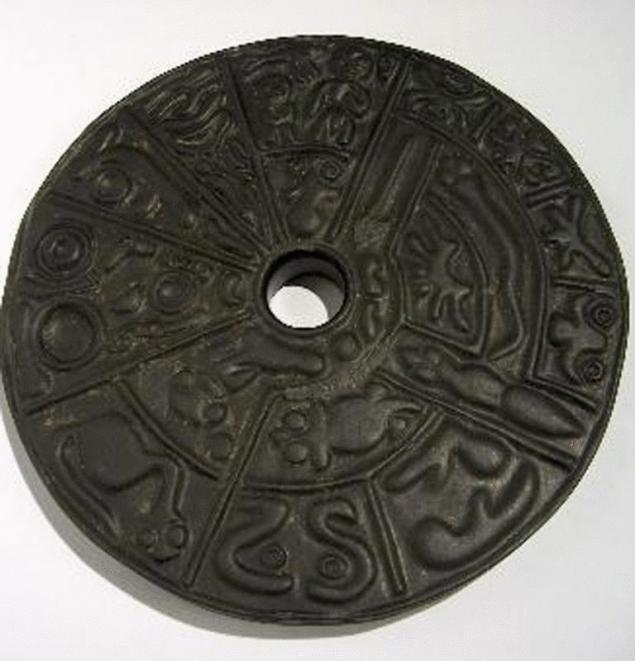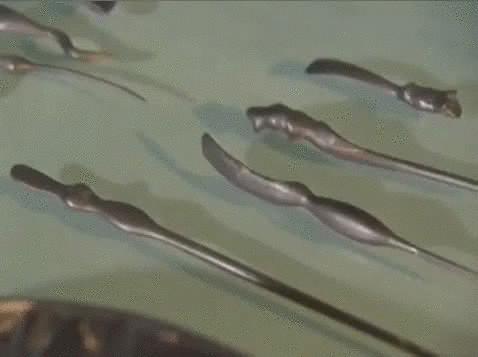1042
Mysteries of archeology: a genetic drive
The so-called genetic drive - one of the most incredible artifacts found in Colombia. The disc diameter of 27 cm is made of durable stone called Lydian stone, surprisingly, that the exceptional strength of this stone has a layered structure. It is argued that to make something like this ancient artifact, and practically and theoretically impossible.

Perhaps it is the same course fake, like the famous crystal skull, or the same dubious mystery as bolts which 300 million years.
However, what is shown on the disc is not less questions. The fact that the disk depicted things and processes that modern man can be observed under a microscope only. Among the images of sperm, stylized genitals and the like on the disc, you can discern the human head image is true, to what race or even mean concerns that person can not be determined.
Although Colombia Archaeological Committee has refused to recognize the genetic drive valuable discovery, let us look at it more ...

About him, the first time, mentioned Erich von Deyniken, and the artifact from the collection of Professor Jaime Gutierrez Lega (Colombia).
"In addition to the plates of copper (or copper alloys) Crespi in a meeting, there are many stone tablets engraved with images and inscriptions in an unknown language. It is noteworthy that these categories of objects, according to Father Crespi, the Indians found in the jungle in underground tunnels and chambers. Padre Crespi argued that from the city of Cuenca in the jungle stretches ancient system of underground tunnels, more than 200 km. On such a system of tunnels he wrote in 1972. Erich von Däniken in his book "The Gold of the Gods". He brought the first images and items from the collection of Professor Jaime Gutierrez Lega. »


The text that accompanies the photographs, the following:
"Embryological disc" is one of the most interesting artifacts from South America. On the front and back of the disc, there are symbols that create different types of images. There is a view that they show the evolution of life from amphibians to humans. Medical experts agree: The CD shows the main stages of human development. The symbols can be identified. Eyes that lie far beyond the rest of the head, as well as a wide nose segment speak in favor of this. These features are characteristic of the early embryonic development of the head structure. But the appearance of the disc can be attributed to what time? Geologists from the University of Bogotá include the date of its origin to the prehistoric era. Recent studies have been unable to determine the falseness of the artifact.
In addition to the disc in the collection of the architect Gutiérrez There are more and medical instruments from the same material. They are very small, but perfectly fall in any hand. Apparently, it's just been puzzling geneticists tools.

The diameter of the disc is 27 cm, and weight - about 2 kilograms. On the drive that marked the image describing the full cycle of the female egg fertilization until birth, which proves the existence of such knowledge among civilizations ancient times. Images of the processes that only under a microscope, you can see in real life. The left side of the disc is 11 hours, you can view the image of the male testicles without sperm from the sperm and apparently there is shown the process of origin of sperm. Left direction about an hour, you can already see a few sperm originated. The longer the image is not clear to us. We need a more detailed study of the biology specialists. On the reverse side of the disc is shown at the top of the embryo in several stages of development. and ending with the fact it looks like a newborn baby. We see the same on the disk in the region of six hours the image of man and woman.
In the area of three hours on a disk image of a man, woman and child are seen, an oddity here is depicted as the head cheloveka.Esli is not a stylistic image that these people are what species. Among the artifacts from liddita is such that the front is the image of a mother with a child, and behind - the men in hunting gear. Next artifact from the collection is a very unusual knife. At the top on the handle of the knife shows the mother's head, and below - the baby's head, neck cord is wrapped. It is obvious that this knife was used to cut the umbilical cord and saving newborn lives.

Among the artifacts there are many other things, explicitly used for medical purposes. For a small amount, they are different forms of the same perfection as the previous ones. Here he writes about them, Professor Klaus Dona: "When we carried out the examination of the material in Vienna, these subjects were examined with the best world specialist. His first conclusion concerns the material - all of these items made from liddita. Regarding the appearance of its final conclusion was this: "I can not tell you either how they were made, not the one who made them. The only thing that I definitely can tell you - it's that we can not today make the same tools of the same material. " Thus, we do not know what these ancient artifacts. Because they are found in Colombia and do not fit into any of the existing pre-Columbian cultures, we have to assume that their age is greater than at least 6000 years. However, we are unable to explain what kind of technology is used to manufacture these tools from liddita ".

Perhaps it is the same course fake, like the famous crystal skull, or the same dubious mystery as bolts which 300 million years.
However, what is shown on the disc is not less questions. The fact that the disk depicted things and processes that modern man can be observed under a microscope only. Among the images of sperm, stylized genitals and the like on the disc, you can discern the human head image is true, to what race or even mean concerns that person can not be determined.
Although Colombia Archaeological Committee has refused to recognize the genetic drive valuable discovery, let us look at it more ...

About him, the first time, mentioned Erich von Deyniken, and the artifact from the collection of Professor Jaime Gutierrez Lega (Colombia).
"In addition to the plates of copper (or copper alloys) Crespi in a meeting, there are many stone tablets engraved with images and inscriptions in an unknown language. It is noteworthy that these categories of objects, according to Father Crespi, the Indians found in the jungle in underground tunnels and chambers. Padre Crespi argued that from the city of Cuenca in the jungle stretches ancient system of underground tunnels, more than 200 km. On such a system of tunnels he wrote in 1972. Erich von Däniken in his book "The Gold of the Gods". He brought the first images and items from the collection of Professor Jaime Gutierrez Lega. »


The text that accompanies the photographs, the following:
"Embryological disc" is one of the most interesting artifacts from South America. On the front and back of the disc, there are symbols that create different types of images. There is a view that they show the evolution of life from amphibians to humans. Medical experts agree: The CD shows the main stages of human development. The symbols can be identified. Eyes that lie far beyond the rest of the head, as well as a wide nose segment speak in favor of this. These features are characteristic of the early embryonic development of the head structure. But the appearance of the disc can be attributed to what time? Geologists from the University of Bogotá include the date of its origin to the prehistoric era. Recent studies have been unable to determine the falseness of the artifact.
In addition to the disc in the collection of the architect Gutiérrez There are more and medical instruments from the same material. They are very small, but perfectly fall in any hand. Apparently, it's just been puzzling geneticists tools.

The diameter of the disc is 27 cm, and weight - about 2 kilograms. On the drive that marked the image describing the full cycle of the female egg fertilization until birth, which proves the existence of such knowledge among civilizations ancient times. Images of the processes that only under a microscope, you can see in real life. The left side of the disc is 11 hours, you can view the image of the male testicles without sperm from the sperm and apparently there is shown the process of origin of sperm. Left direction about an hour, you can already see a few sperm originated. The longer the image is not clear to us. We need a more detailed study of the biology specialists. On the reverse side of the disc is shown at the top of the embryo in several stages of development. and ending with the fact it looks like a newborn baby. We see the same on the disk in the region of six hours the image of man and woman.
In the area of three hours on a disk image of a man, woman and child are seen, an oddity here is depicted as the head cheloveka.Esli is not a stylistic image that these people are what species. Among the artifacts from liddita is such that the front is the image of a mother with a child, and behind - the men in hunting gear. Next artifact from the collection is a very unusual knife. At the top on the handle of the knife shows the mother's head, and below - the baby's head, neck cord is wrapped. It is obvious that this knife was used to cut the umbilical cord and saving newborn lives.

Among the artifacts there are many other things, explicitly used for medical purposes. For a small amount, they are different forms of the same perfection as the previous ones. Here he writes about them, Professor Klaus Dona: "When we carried out the examination of the material in Vienna, these subjects were examined with the best world specialist. His first conclusion concerns the material - all of these items made from liddita. Regarding the appearance of its final conclusion was this: "I can not tell you either how they were made, not the one who made them. The only thing that I definitely can tell you - it's that we can not today make the same tools of the same material. " Thus, we do not know what these ancient artifacts. Because they are found in Colombia and do not fit into any of the existing pre-Columbian cultures, we have to assume that their age is greater than at least 6000 years. However, we are unable to explain what kind of technology is used to manufacture these tools from liddita ".























